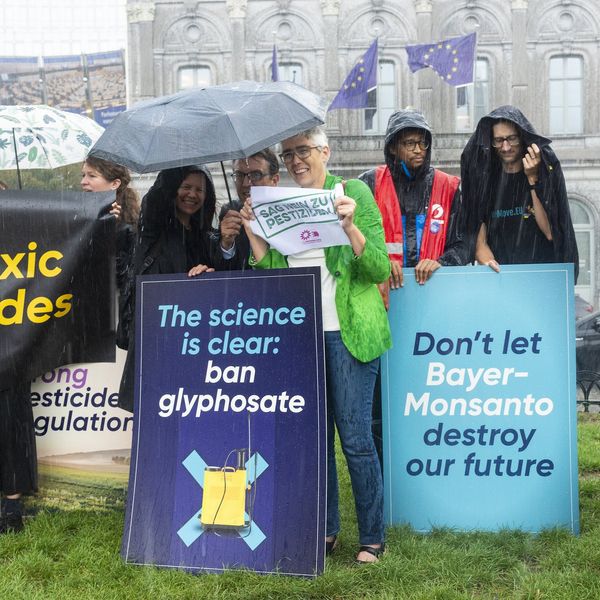Editor’s note: This is part of an ongoing series, BPA's evil cousin.
Last year, Washington state passed precedent-setting rules prohibiting bisphenols as an entire class of chemicals in several products, including food and drink cans and thermal paper. These chemicals disrupt proper hormone function and are linked to health harms from cancer to diabetes to reproductive problems.
Bisphenols were one of five chemical groups banned by the new rules under the state’s 2019 Safer Products for Washington Act, which allows for large groups of chemicals to be regulated at once. While many states have or are passing laws to ban whole classes of chemicals such as per- and polyfluoroalkyl substances, also known as PFAS, in certain products, Washington’s ban is different because it’s not a one-off law. It requires regulators to continue selecting groups of chemicals to restrict or eliminate when safer alternatives are available, every five years.
The law differs from the standard risk assessment chemical-by-chemical method. Typically used by federal agencies in the U.S., it is slow and costly, leads to regrettable substitutions and fails to protect public health, experts say. In contrast, “the class approach prevents companies from leaping from one structurally similar chemical to another because that's just so easy to do and stay ahead of the regulatory environment,” Mark Rossi, executive director at the non-profit Clean Production Action, told EHN.
For example, when pressed to remove bisphenol A, or BPA, from consumer products during the 2000s, manufacturers switched to other similarly harmful bisphenols, like bisphenol S and bisphenol F.
“The class-based approach short circuits that from happening,” Rossi told EHN. “It says we want to avoid that class because of the patterns that we've seen from other chemicals using the same chemical elements, and so that forces a switch” to a wholly different chemistry.
The chemical industry rejects this approach.
“ACC and others disagree with a class-based approach to the regulation of chemicals. This approach is neither scientifically accurate, nor appropriate,” Tom Flanagin, senior director at product communications at the American Chemistry Council, wrote to EHN.
Ideally, the class-based approach eliminates the need to collect data on every chemical in a specific class to act on it, ensuring regulators don’t overlook data-poor or under-studied chemicals like bisphenol A diglycidyl ether, also known as BADGE, which is used to make epoxy resin glues, paints and coatings for everything from food can liners to automotive paints. This chemical shows a similar ability as BPA to cause harm, but has consistently flown under regulator’s radars.
However, class-based regulations are not a silver bullet. Depending on how you define “like-chemicals”, BADGE could slip away from new rules, experts told EHN.
Moreover, for the class approach to overcome industry resistance, regulators need to develop frameworks that allow for exclusion of chemicals deemed safer within groups. They also need to allow for essential uses of banned chemicals when safer alternatives are not yet available.
How do you define a class of chemicals?


BADGE, which is used to make epoxy resin glues, paints and coatings for everything from food can liners to automotive paints, shows a similar ability as BPA to cause harm but has consistently flown under regulator’s radars.
Credit top photo: Unsplash; Bottom photo: Collab Media
Washington state’s new law groups chemicals into classes based on their structure. The state’s Department of Ecology defines a bisphenol as “a chemical with two phenol rings connected by a single linker atom,” each of which may have “additional substituents.” Grouping chemicals this way “gives a clear bounds for how we communicate what is in and out of scope, and that's important for our stakeholders,” Marissa Smith, a regulatory toxicologist at Washington’s Department of Ecology (DOE), told EHN.
While DOE’s approach captures dozens of BPA look-alikes, such as BPS, BADGE evades its regulation because it doesn’t fit the definition – which begs the questions: how do regulators decide which chemicals are structurally similar? And how do they know whether like-structures will have similar adverse health effects?
There are tools for answering such questions. Some experts use the Tanimoto Score to determine chemical likeness; chemicals scoring 80% or higher are considered structurally similar to the chemical in question. The U.S. Environmental Protection Agency’s (EPA) CompTox Chemicals Dashboard is based on this scoring system. The National Academy of Sciences, Engineering and Medicine also used it to assess the scientific soundness of banning organohalogen flame retardants as a class in 2019.
The academy determined that this type of flame retardant wasn’t structurally similar enough to be placed into one class, but that they could be placed into two subgroups for regulatory purposes. “Although the challenges to a class approach might appear daunting, the alternative— individual assessments of hundreds of chemicals—is unrealistic,” the report concluded. “The only possible practical approach for a set of chemicals as large as the [organohalogen flame retardants] is a class approach.”
Subgrouping chemicals may be more palatable to industry, Flanagin told EHN. A “subgrouping approach—grouping of some substances within a class based on similar physical, chemical and biological properties—may be possible,” he said, pointing to EPA’s National PFAS Testing Strategy as an example.
Ted Schettler, science director at the Science and Environmental Health Network, also used the Tanimoto Score to develop a hazard screen listing more than 40 bisphenols that industry should avoid. Schettler found that bisphenols scoring 90% or higher had “very similar hazardous properties to BPA.” “As the score goes down, there's more chance that they will not have quite the same hazardous properties,” he told EHN, though that doesn’t mean the chemical isn’t harmful.
BADGE’s Tanimoto Score is less than 80%, so Schettler didn’t include it in the hazard screen.
However, there are other ways of grouping chemicals that could capture those that are harmful, like BADGE. Using a health-based approach that classifies chemicals by their intrinsic hazard, such as their ability to disrupt hormones or the organs they target (or a combination of these), might prove useful.
Health-based approach
Grouping chemicals by their health effects, rather than their structures, could put BADGE in a class with other bisphenols, Maricel Maffini, independent consultant and lead author on Advancing the Science on Chemical Classes, told EHN.
Maffini views this approach as more protective. Chemicals “may or may not have similar structures, but if they are affecting the same organ sooner or later the organ is going to give up,” she said.
As an example, Maffini points to the 1958 U.S. Food Additives Amendment, which requires the Food and Drug Administration (FDA) to evaluate the cumulative effect of chemicals that are either chemically or toxicologically related and treat them as a class. “Congress was very prescient when they wrote that because they said [food additives] could lead to chronic health effects and we are exposed to many different additives in food at the same time…[and] they may be targeting similar organs,” Maffini said.
A group of chemicals that affect, say, the thyroid could be considered together, Maffini explained. “You could look at them as a class, identify the worst and either get rid of it or create a reference dose based on it. You then have a reference dose for the entire group, rather than five different safe doses” based on the most toxic chemical.
The European Food Safety Authority does this for pesticides, calculating a cumulative risk based on pesticides’ health effects, not their chemical structure. EPA takes a similar approach with organophosphate pesticides, though it has a far narrower definition of what constitutes “similar toxicological impacts.”
The problem with grouping chemicals solely by hazard, however, is that you can miss chemicals that are data-poor. That’s why testing is still “the most important thing” for ensuring that chemicals like BADGE don’t escape regulators’ attention, Terrence Collins, Teresa Heinz professor of green chemistry at Carnegie Mellon University, told EHN. Chemicals must be thoroughly tested, including for their long-term effects at low doses and for a broader range of harms, such as their ability to disrupt the body’s hormonal system and harm the brain or the immune system, he said.
Testing is also critical to ensure that you're not substituting one chemical class with another harmful class, Rossi said. The French organization l'Ineris, for example, lists dozens of substitutes for bisphenols made from styrene or acrylonitrile, which are also harmful to health. Similarly, manufacturers now use a BPA-alternative called Tritan, which some experts warn has not been adequately vetted.
“One doesn't want to simply escape BPA — one wants to move from unsafe and unsustainable to safe and sustainable,” said Collins.
Ultimately, a combined structural and hazard-based approach may be needed.
Prospects for chemical regulation based on class

Regardless of whether a health-based, structure-based or hybrid approach is used to group BADGE with other bisphenols, passing a class-based federal regulation would be a tall order.
The FDA shows zero interest in regulating bisphenols.
And the “EPA just lags on this—like everything—badly,” Rossi said.
In fairness, the Toxic Substances Control Act, or TSCA, which requires a cumbersome process for evaluating chemical hazards, limits the EPA’s authority.
“While it might make sense to regulate bisphenols as a class, under TSCA, there's a lot of barriers to EPA doing that, even outside of their own intransigence or industry pressure,” said Daniel Rosenberg, director of the federal toxics policy, people and communities program at Natural Resources Defense Council. “It would create some new complexities that the agency would have to deal with.”
Jeffrey Landis, an EPA spokesperson, told EHN that “[The Act] allows the agency to prioritize, evaluate and regulate a category of chemicals as a ‘chemical substance’ that could include, for example, several bisphenols in addition to bisphenol-A.” But the agency “has not yet prioritized BPA for TSCA risk evaluation.”
Congress could pass legislation reforming the Toxic Substances Control Act to allow for a more substantial class approach, but that’s unlikely. The act was reformed in 2016, through a painful, lengthy process. “I don't think the scars have even healed adequately for anybody to want to go down that path,” Rosenberg said.
Both Rosenberg and Rossi point to more focused actions that Congress could take to address chemicals by class, like the recent bipartisan effort to restrict PFAS through the National Defense Authorization Act.
Ultimately more states will have to follow Washington state’s lead, and as they do, it will be easier for EPA to “bring up the rear, or for Congress to act,” said Rosenberg.
Exceptions in chemical class approaches
Washington’s ban on bisphenols excludes one, tetramethyl bisphenol F, which has been extensively studied and found to behave differently biologically from other bisphenols.
“An important concept in class-based chemical regulation is that you are inherently making assumptions when you group a bunch of chemicals together. There’s always this variability and you can't just close your eyes and ignore it,” Smith said.
However, some experts think the jury is still out on this alternative, and even Smith acknowledges some uncertainty. “While there is some evidence of endocrine activity, we weren't necessarily able to see a connection to an adverse response,” she said. “And for that reason, we concluded that this is a safer alternative to the rest of the bisphenol-based epoxies and exempted it from our rule. We don't want class-based regulations to hinder development of truly safer chemicals.”
Moreover, Washington’s bisphenol restrictions notably do not cover polycarbonate plastics, where the vast majority of BPA is used, such as for blenders or food processors. Equity and concerns about disproportionate exposure to bisphenols in canned food and from occupational exposures to thermal receipts drove the agency’s priority setting, Smith said.
But “it doesn't mean that there aren't other sources of exposure where safer alternatives may be feasible and available,” she added. “I expect that we will be going back and identifying more products for bisphenols. We can’t do everything at once.”
Washington’s law requires that a safer alternative must be available before a chemical is banned for a particular use, a concession it made to get industry on board. Other approaches to mollify industry, such as in the battle over PFAS regulations, include carving out exemptions for essential uses.
As industry representative Tom Flanagin told EHN, “overly broad regulation of chemistries can threaten access to products needed for critical sectors, including semiconductors, aircraft, solar panels, electric batteries, medical devices, life-saving drugs and more.”
“That's fine, have some critical uses of these chemicals,” Rosenberg said, “but it doesn't mean that we should just blanketly stop trying to address the problem.”
Ultimately, “protecting the public from harmful chemicals like BADGE requires a multidisciplinary approach,” said Collins. “It essentially demands transformation of the chemical industry.”
Read Part 1, How BPA and its insidious, evil cousins continue to dodge meaningful regulation . And see our full series on BADGE, BPA’s Evil Cousin.
- Op-ed: How the FDA ignores the law when approving new chemical additives to food ›
- Concerns raised over ‘regrettable’ BPA substitutions ›
- More bad news for BPA: Novel analysis adds to evidence of chemical’s health effects ›
- Exposed: How willful blindness keeps BPA on shelves and contaminating our bodies ›
- The hidden, potential cancer-causing, danger in woodworking and art supplies ›
- BPA's evil cousin ›
- BADGE at the “very top as a chemical of concern” for workers handling epoxy resins ›




























